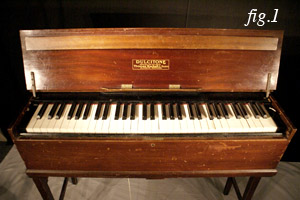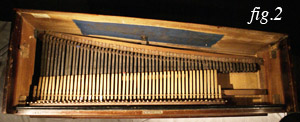|
The Dulcitone is classified as an idiophone with a set of percussion plaques
like a metallophone[1]. It is a tuning fork piano where there are pieces of
metal bent into a U-shape, which is the fork. Most Dulcitones have 61 keys
or are 5 octaves, but there are some with 45 keys[2], , which makes the instrument
quite small. They had hinges for the legs so that they can be folded
(as shown in fig.1) and the overall instrument was very light, making it
easy to transport like an acoustic version of a small electric keyboard.
The sound of the Dulcitone is very soft can be sustaining depending on the
quality of the forks. The forks are struck with hammers like the ones on the
piano with the soft felt material[3]. To compare the Dulcitone with a conventional
instrument, the glockenspiel can sound very much like the Dulcitone if you used a soft beater.
To look inside of the Dulcitone (fig.2), you can take the keys off by lifting on the looped string as shown in fig.1 where the yellow arrows point. Inside the body, everything is tightly compact and easy to disassemble. There are wooden strips, which are the dampers and the darker grey strips are the forks. There is a longer strip of wood that runs across over all the dampers which is strung to the sustain pedal. When you use the pedal the long strip of wood is pulled by the string and holds down all the individual dampers.
|
|
In fig.3, this is the top keyboard part, which just lifts off from the body; it is quite heavy because it holds all of the hammers and to lift the keyboard off with the looped string on either side feels very precarious.
When you turn the keyboard upside down, you can see the overall mechanism and if you look long enough, it is not all as complex as how piano keys work. The hammers strike the note from above rather than below like on the piano. So there is no complexity of making the hammers raise up to hit the note. In fig.5, this is a cross section diagram of how piano keys work, there is quite a complex structure underneath the hammer with more pivot points and levers.
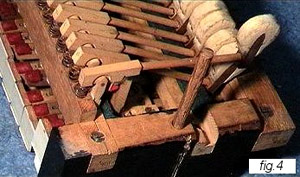
|

|
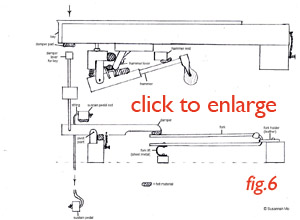
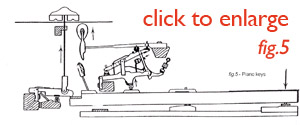
|
In fig.6 (left), this diagrams shows how different the structure is compared to the piano keys; the materials may also be quite different too maybe because of limited metals. The Dulcitone can be very delicate and it is mostly made of wood. With pianos now, there are stronger materials, which can last longer and can be played for dramatic pieces of music.
The forks are made of very thick (as shown in fig.7) pieces of metal bent into a 'U' shape and they differ in length for the correct pitch. They are held up by a thinner sheet of U-shaped metal that is bolted on which is then screwed onto the base of the body. To secure the fork, a piece of leather is used to hold the bend of the fork that is screwed on a piece of wood. One of the disadvantages of the Dulcitone is how easily it is to damage the instrument; the sheet metal under the fork has a tendency to break if the fork is hit too hard, and it can be difficult to repair because the fork is fastened on with a rivet pin rather than a screw. It is said that the Dulcitone is more of an instrument for quieter domestic use, but Vincent D'Indy wanted to prove people wrong and so he used the Dulcitone in one of his pieces, Le chant de la cloche[5] in 1883. It is also mentioned that on the same year, he used the Typophone in his score[4], which may be true because in France, the Dulcitone is known as the Typophone[5a]. Both of these instruments were very similar and their names could get mixed up, they are two different instruments.
|
|
Inside the Dulcitone, the dampers lift off when you press a key just like on a normal piano; the mechanism is quite similar to a piano and a lot simpler. On fig.8, I am pressing the pad where the key would press to lift up the damper from on the fork.
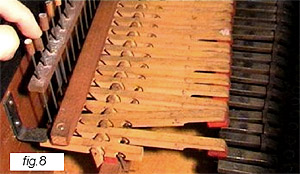
|
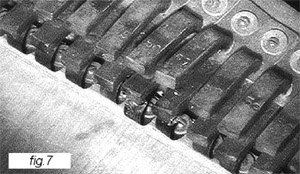
|
|
Beginnings
It was Thomas Machell (b.1841-1915) who made his name widely known for the Dulcitone since 1860 in Glasgow; he then perfected the instrument in 1880[6]. The very first tuning fork keyboard came from experimentation after the invention of the tuning fork in 1750s; Irishman Charles Clagget[7] created the Aiuton in 1788. This instrument worked quite differently compared to the Dulcitone, it was a friction-bar piano with a rotating metal cone that bowed a row of forks[8].
The next tuning-forked instrument was by Victor Mustel who created the Typophone in 1865[9] and it is known to be quite similar to the Dulcitone having 49 forks inside resonator boxes that were struck by hammers. In three years, the Typophone was improved, but then forks became abandoned for metal bars. The Typophone was not popular and died away very quickly making little information and no images of it. It is not said if Machell had known of the Typophone to build the Dulcitone.
Other instruments made at the time were the Adiaphon by Fischer & Fritz of Leipzig in 1882 and the Euphonium by A. Appunn of Hanau. Both of these instruments were very soon forgotten leaving very little information about them.
|
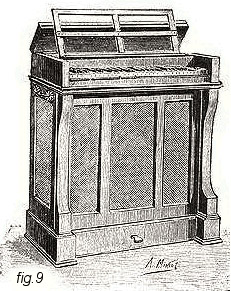
|
Celesta
The Typophone probably had inspired Auguste Mustel who was son of Victor Mustel, he continued with the metal bars as developed from the Typophone, which then he created the Celesta in 1886.
The celesta is probably the most successful of the keyboard metallophone mainly because of its success in volume compared to the older instruments[8]. It is this instrument that became much like a glockenspiel by having individual resonators for each metal bar5. Auguste Mustel may have also been inspired by the Gender, a Javanese metallophone from the Gamelan, because of the bamboo resonators[6].
Even today there are still many celestas being used, it is said that Ernest Chausson may have been the first to use a celesta in an orchestra in 1888. Other composers using the celesta include Bartók in Music for Strings, Percussion, and Celesta (1935), Richard Strauss in Der Rosenkavalier (1911) and probably the most well known piece The Dance of the Sugar Plum Fairy (1892) by Tchaikovsky with for his ballet[8].
|
|
The Dulcitone Now
The Dulcitone has now become an item of the past, it is no longer used like before and it has become a collector's item of antiques. There are many websites it features in for auction and buyers know little about the instrument and its past. It is scarcely listed in books and dictionaries, when it is, it would be a very brief description or under the heading 'celesta' or 'tuning-forked instruments'.
|
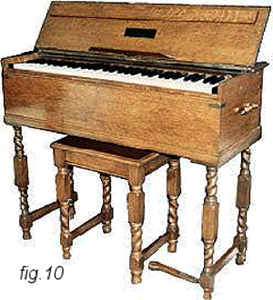
|
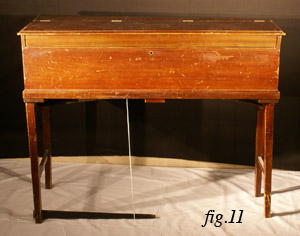
|
|
The number of Dulcitones left is not clear but it is said that only five remain[10], but after searching through message boards on an antique website[11], there could be about twenty and possibly a lot more. There are also two different types by design; there is the early original, oak cased from 1800's (fig.10), and the later version (fig.11) believed to have been made from the 1920's[12]. This may be because Machell died in 1915 so his sons may have redesigned the model.
It is not certain when the Dulcitone stopped being made, dates have been mention from 1920's to 1939[10]. It is likely to have been late 1920's to early 1930's if Machell' s sons continued making after he had died.
Performances
Very few composers used it to perform, which may have been because of its low volume. As mentioned before Vincent D'Indy may have been the first person to use the Dulcitone, and if not him because of the typophone, then maybe Percy Grainger in his piece The Warriors (1913-1916). There are no more composers of the Dulcitone found, but until searching the Internet, possibly the latest person who used one is David Rhodes. He had to rebuild his instrument and then he used it for a duet for the baroque lute and the Dulcitone. He did a number of performances and recorded a CD in 2001 with Karen Boyd on Dulcitone.
Conclusion
So the Dulcitone is a small, sweet-sounding tuning-forked piano that came previous before the celesta. It was invented my Thomas Machell (1841-1915) in Glasgow in 1860, which was then improved in 1880. It was made for about 60-80 years and only about to 2000 was made[10], whether that is true it is not certain. It has been in very few performances and was more a practise instrument. A very delicate instrument which may have brought the making of the instrument to stop.
With little information found, the dates and facts mentioned may not be accurate and there should be more details, but it is a matter of searching for the facts.
If you would like more details about dulcitones, drop an email to info@sumo55.co.uk subheaded 'Dulcitone'. I'll be only too pleased to hear from you.
|
|
1 - Sadie, S, ed. The New Grove Dictionary of Music and Musicians. (2001). Page 335.
2 - Axiom Associates Ltd. http://www.bristolauctionrooms.com/mickleburgh/lots/128.html (no date).
fig.1 - Axiom Associates Ltd. http://www.bristolauctionrooms.com/mickleburgh/lots/152.html (no date).
3 - Primary source.
fig.2 - Primary source. © 2004 Susannah Mo
fig.3 - Primary source. © 2004 Susannah Mo
fig.4 - Primary source. © 2004 Susannah Mo
fig.5 - Diagram from The Vestal Press, Vestal, N.Y.
fig.6 - Primary source. © 2004 Susannah Mo
fig.7 - Primary source. © 2004 Susannah Mo
fig.8 - Primary source. © 2004 Susannah Mo
fig.9 - Compton's Interactive Encyclopaedia Deluxe. (1998). The Learning Company.
fig.10 - Lebar, R. http://www.alphaentek.com/rhodes.htm (2004).
fig.11 - Primary source. © 2004 Susannah Mo
4 - Dearling, R, ed. The Ultimate Encyclopaedia of Musical Instruments. (1996). Page 111.
5 - Kennedy, M. The Concise Oxford Dictionary of Music. 3rd ed. (1980). Page 192.
5a - Baines, A. The Oxford Companion to Musical Instruments. (1992). Page 51.
6 - Sachs, C. The History of Musical Instruments. (1968).
7 - Marcuse, S. A Survey of Musical Instruments. (1975). Page 108.
8 - Vienna Symphonic Library GmbH. http://www.vsl.co.at/english/instruments/drums/mallets/celesta/History.htm (2002).
9 - Marcuse, S. A Survey of Musical Instruments. (1975). Page 37.
10 - Wofford College. http://www.wofford.edu/whatsnew/news/archive2001/20010307.htm (2001).
11 - Antiques and the Arts. http://www.antiquesandthearts.com/forumresponse.asp?var=176&var2=22 (2004). Bee Publishing Company
12 - Notes from a previous owner of an 1897 Dulcitone.
|

